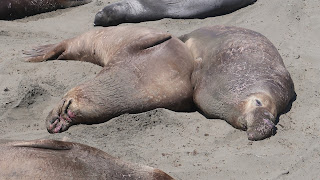Easy living on the beach
Elephant seal bulls take a break
Summer is molting season for the elephant seal bulls.
They are at rest, so viewing of their big noses and chest shields is excellent.
Catastrophic molt
All elephant seals molt their skin once a year. Pups
molt when they are weaned, young seals and females molt in May and June. the
bulls in July and August. Their coats’ color ranges from gray to brown and tan,
although they look black when they arrive on the beach, wet and shiny. Last
year’s brown layer of epidermis and fur peels off, revealing pearly gray fur
underneath. The new coat will become tan and brown as the individual hairs
finish growing out and stand up.
Friends of the Elephant Seal docents, in blue jackets,
can let you handle pieces of the shed skin. The fur is short and stubbly, often
compared to Astroturf. These seals rely on their blubber for warmth, not their
fur.
The seals have to stay on the beach while they are
molting. Blood flow increases to the new skin, and the seals would lose too
much heat in the cold water. Molting takes about a month for each seal. They
come and go individually, so molting seals are on the beach for a couple of
months.
Bites must have been serious to produce some of these
scars, but the seals survived. I like to think that blubber doesn’t have many
nerve endings. It doesn’t have much blood supply, so the wounds don’t cause
major blood loss.
Bulking up
The most dominant bulls spent as long as 100 days on
the beach during the breeding season, November through March, defending their
harems. They were at the low point in weight. The bulls have been feeding since
they arrived at their northern foraging areas in March, after the breeding
season.
The pile of bulls now on the beach looks fat and
comfortable.
Bellowing in the mist
The beach is relatively quiet in the summer, but some
bulls bellow their presence, from the water or on the beach. Adult bulls have
unique calls, like having a name. They recognize each other, and remember
whether they have fought in the past. Having settled who was the winner in the
past, they don’t need to fight again. It helps reduce aggression.
For more on the seals’ vocalizations, watch a LabsideChat video with Caroline Casey, who researched the bulls’ calls.
See how she records the seals here.
Very carefully!

.JPG)

